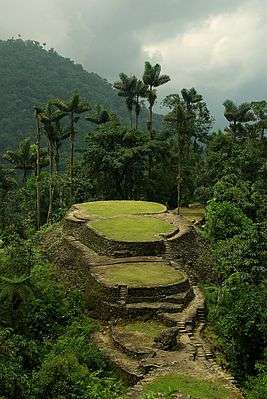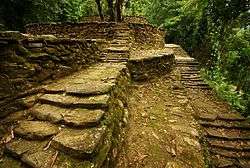Ciudad Perdida de Teyuna
Ciudad Perdida ("Lost City" in Spanish) is an ancient, ruined city located in the Colombian jungle close to Santa Marta.

Understand
The city was built between the eighth and the fourteenth centuries by the Tayrona Indians. Nowadays only circular stone terraces covered by jungle remain, but the views and the location of the site are extraordinary. The local name for Ciudad Perdida is Teyuna.
Get in
Treks to Ciudad Perdida are arranged by five different authorized companies in Santa Marta and Taganga. It is not possible to visit the site on your own. The government made an agreement with tour companies that every tour cost COP$950,000, regardless of whether it lasts for four, five or six days. Depending on the season, tours may leave every day or every few days - if you have one or two travelling companions, you are almost assured to be able to leave on the day of your choice.
Make sure to bring appropriate gear for trekking, including good walking boots, mosquito repellent, a sleeping bag, appropriate clothing for hiking and for nights, and a water bottle. You will also want to take a pack of cards, a small amount of cash, a torch, toilet roll, hand sanitizer or soap, snacks and a book.
- 🌍 Expotur, Calle 18 No.2-07, next to the soccer field in Taganga. Carrera 3 No. 17.27 Local 3 Edif Rex Santa Marta, ☎ +57 54 420 7739, +57 3114182706 (cell), e-mail: info@expotur-eco.com. Expotur is the newest operator but is very professional and promotes sustainable community tourism working with indigenous Koguis and rural communities. They have good local and certified guides and frequently offer English translators. Expotur advertise that they have tours to Ciudad Perdido every day.
- 🌍 Guias y Baquianos Tour, Calle 10C #1C-59 In the Hotel Miramar, ☎ +57 5 431 9667, +57 317-6611-635 (cell), e-mail: info@guiasybaquianos.com. Guias y Baquianos has more than 30 years' experience and helps the indigenous and rural communities. They also offer English translators.
- 🌍 Magic tours (Calle 14 No. 1B -50, Santa Marta), ☎ +57 5 421 9429, +57 5 421 94 72, +57 317 6792441 (cellular), e-mail: magictour186@yahoo.com. 8AM.
- 🌍 Turcol, Calle 13 No 3-13, Santa Marta, ☎ +57 5 421 2256, e-mail: turcoltravel@gmail.com. Turcol has the longest experience operating this trek. They are committed to local communities, have a really good customer service and frequent tours with English-speaking interpreters.
- 🌍 Wiwa Tour, Santa Marta Carrera 3 No.18-49, ☎ +57 5420 3413, e-mail: info@wiwatour.com. The Lost City is a sacred site for the region's indigenous people and forms part of their reservation in the Sierra Nevada. This is the only indigenous owned agency in town and the only agency that will take you to the Lost City with indigenous guides.
Note that helicopter tours were outlawed in 2010 after studies demonstrated that the helicopter landings were causing site deterioration.
Typical itinerary
The whole trek is 44 km long. It is offered as a 4-, 5- and 6-days tour. All of them have approx. three hours at the archeological site itself.
If taking the 5 days (4 nights) variant, the trekking times per day are approx. 4½ hr, 8½ hr, 2 hr, 4½ hr, 4½ hr.
See
- During the trek you will pass many little streams and waterfalls, some of which you can swim in, and which have great views. There are several steep uphill climbs (the worst one takes about an hour on the first day), but it is worth it. Overall, because of afternoon rains, you only hike for about 3–4 hours per day (depending on the duration - you will walk more per day on the 4-day trek).
- Although the community atmosphere while walking is great, it is also fun to spend an hour or so away from the group while trekking to see more wildlife, particularly on the 3rd day.
- During the trek you will also cross many indiginous in their typical white dress.
Do

- You will end up playing cards a lot during rest periods; it gets dark quite quickly and while the thought of walking in the jungle sounds good, you will be knackered. Plus, it's not a great idea to go wandering about at night outside of the camps.
- In addition to playing cards, make sure to bring a book and some kind of reading light for the downtime each day and night.
- Take advantage of opportunities to swim when you can! But as soon as it starts to rain, get out and get uphill—you are about to witness a tropical flash flood.
- As much as you might want to just put your head down and keep walking, take the opportunity to watch for wildlife or take in the amazing scenery.
Buy
In addition to the occasional beer or Gatorade purchasing possibility listed below, you can bring a bit of extra cash to negotiate for random items from people you meet. It is illegal—despite difficulty of enforcement—for non-military personnel to have in their possession official Colombian military uniforms or equipment.
If you want to get a photo with the soldiers in the city itself then a small present will get you all the time in the world with them. Think about what a young boy trapped in the jungle for 8 weeks would like, think sweets and magazines with plenty of pictures.
Eat
Meals are included in the price of the tour. The food is basic and scrumptious after intense activity, with plenty of beans, rice, and meat, plus a bit of salad. Dinner and lunch are accompanied with... Tang? Don't worry, you'll be tired enough where everything tastes fantastic. Expect a break or two during the day's hike to stop and refuel with a sugar kick from some fresh fruit.
Drink
Bottled water, gatorade, Coca Cola and beer are sold on most of the campsites for COP$2000-3000 each. Prices go up the further you go and reach COP$5,000 at the last camp. Bring extra cash! Better yet, pack a full bottle of something stiff to uncork and share with your new friends after reaching the city.
Sleep
Sleeping space is either in hammocks strung out under a communal shelter, or in small bunkbeds under netting. Some cabañas even have tents so you can snuggle with another trekker. Blankets are provided if you ask; it's worth asking for one even if the evening is warm as it can get very cold at the higher altitudes.
Cope
Showers are available at the camps along the way (but lingering in the rivers during crossings makes for a good rinse in the meantime). Just be aware that remaining dripping wet for extended periods in an already humid environment can lead to fungal infections and just generally smelling bad, so it is good to dry off completely after swimming, showering, etc.
Bring at least one full bottle of bug spray and at least one pair of long pants and one long-sleeved shirt to protect yourself from the swarms during rest periods and breaks. Mosquitoes and biting flies are a constant nuisance, especially when you are resting or stopped at camp - when you are actually hiking and moving the problem is much less severe. Bring more bugspray than sunscreen, as often you will be hiking with substantial tree cover.
For each piece of electronic equipment you choose to bring (cell phone, camera, iPod, etc.), purchase a waterproof, crushproof drybox.
Footwear - an absolute must is a pair of quick-drying, teva-like sandals for river crossings. The actual hiking can be done with hiking boots, hiking shoes, or tennis shoes. For most people hiking boots are advisable as the terrain can be extremely rocky, muddy, and most important - slippery. Probably the most important consideration is to bring a pair of shoes that have a strong grip and are well broken in.
Also bring dry clothes to change into at night - during the rainy season, you should expect to be totally soaked by the afternoon rain. A rain cape covering you and your backpack is also a good idea.
Be warned that many people - sometimes 80% of a group - get sick with stomach problems, diarrhoea and/or vomiting due to hygienic problems. Bring your own water purification pills, hand disinfectant and medication and maybe leave the salad aside to reduce your risk!
Go next
If you feel that the Lost City trek is too expensive or takes to long to fit in your travel plans, consider doing the short trek to El Pueblito in Tayrona National Park.
All tours normally start and end in Santa Marta or Taganga. If you talk to your tour company they can also pick you up (or drop you off) at La Aguacatera (on the street to Palomino) or at the entrance of Tayrona National Park.